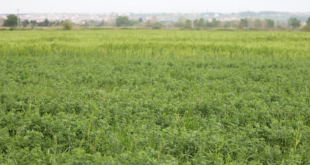
Svein Tore Holsether
President and Chief Executive Officer, Yara International.

Grant F. Reid
Chair of the Sustainable Markets Initiative (SMI) Agribusiness Task Force, former CEO of Mars Incorporated
In past years, we’ve seen regenerative agriculture move from a being more of an elusive concept to a proven solution, and an answer to the future of farming. Yet despite the clear benefits, it is not scaling fast enough. To us, this is both frustrating and encouraging: frustrating because the solutions are already available; encouraging because we don’t have to reinvent the wheel.
As defined by One Planet Business for Biodiversity (OP2B), regenerative farming aims to enhance the farm ecosystem, rather than exhaust it, through nature-based solutions.

In November, the Sustainable Markets Initiative Agribusiness Task Force launched the report ″Scaling regenerative farming: An action plan″. In it, we highlight that
- Regenerative farming on 40% of the world’s cropland would save around 600 million tons of emissions. This is around 2% of the total, equivalent to the footprint of Germany.
- But in order to limit climate change to 1.5 degrees, it must be scaled faster, and move from covering around 15 % of global cropland today to 40 % by 2030.
Regenerative Farming’s Benefits
So, how do we get there? Below, we list 5 concrete routes to reach scale. But before that, let’s look at the benefits of regenerative farming.
Together, we have spoken with farmers on all continents the past year, and witnessed first-hand regenerative farming’s impact:
1. Climate. It helps mitigate emissions such as through carbon sequestration and improved crop resilience for climate shocks.
2. Soil Health. It improves soil fertility through increased biomass production, thereby preventing soil degradation.
3. Resource use efficiency. Higher nutrient use efficiency (NUE) increases crop yield and optimizes land use efficiency, while improved water use efficiency reduces the stress on freshwater reserves.

4. Biodiversity. More diverse rotation and reduced pesticide usage supports biodiversity on farms while, in some cases, higher crop yields mean more natural habitats can be protected rather than cleared for agriculture.
5. Prosperity. Regenerative agriculture improves long-term farmer livelihood through reduced costs, improved crop yield and crop quality, and greater resilience to market volatility and extreme climate events. It also opens new green revenue streams for farmers, such as rewarding them for carbon capture and storage in the soil.
Why is it not scaling faster?
With these kinds of benefits, it seems obvious that the food value chain – all the way from the farmer to the consumer – would want to push for regenerative practices. So why is it not scaling faster?
Our work identified that the single most important reason for the lack of scale is that we have not succeeded in making regenerative farming commercially attractive enough in the short term for the farmers. The risk and cost of transition is the key priority that must be tackled, and we believe there are five ways to do it:
1. Agree on common metrics for environmental outcomes. Today, there are many disparate efforts to define and measure environmental outcomes. We must move to a set of metrics adopted by the whole food industry, making it easier for farmers to adjust their practices and for positive changes to be rewarded.
2. Build farmers’ income from environmental outcomes such as carbon reduction and removal. We need a well-functioning market with a credible system of payments for environmental outcomes, trusted by buyers and sellers, that creates a new, durable, income stream for farmers.

3. Create mechanisms to share the cost of transition with farmers. Today, all the risk and cost sits with the farmers. It is impossible to achieve systems transformation without sharing the burden and benefits through the value chain.
4. Ensure government policy enables and rewards farmers for transition. Too many government policies are in fact supporting the status quo of farming. That has led us to a broken food system. The food sector must come together and work jointly with regulators to address this.
5. Develop new sourcing models to spread the cost of transition. We must move from sourcing models that take crops from anywhere to models that involve collaboration between off-takers from different sectors to take crops from areas converting to regenerative farming.
The solution to both the climate emergency and the food crisis is in the soil, quite literally. Farmers are stewards of the soil and they must be incentivized and rewarded as such. We call on players across the food value chain to commit to achieving that by helping progress these 5 key areas and unlock regenerative agriculture at scale.
Source: World Economic Forum
 THE GLOBAL WINDOW OF TURKISH FOOD AND AGRICULTURE The Global Window of Turkish Food and Agriculture Sector
THE GLOBAL WINDOW OF TURKISH FOOD AND AGRICULTURE The Global Window of Turkish Food and Agriculture Sector









